As the story went, some key members in what to become j-phonics today began to realize two years ago that there is a need among users for a new pro-level universal fitted IEM that not only offers the same sound quality as in custom, but also the same level of comfort in fit. By combining their expertise on different fields, a group of Japanese designers, technicians and engineers started to collect and study data, refine models, and fine tune the sound. In the end, the company j-phonic is born and begins to offer to the market what they believe to be some of the best universal IEM in the market, the j-phonic K2. The K2 comes in two flavors: the SP (or “Stage Performance”) version which I am about to review here is mainly tuned as a stage monitor, aiming for neutral while highly detail sound. The MX (or “Music Extreme”) version is said to have a slightly bassier sound with a smoother top, offering a more musical presentation for the music listener. Of course there is no limit in which version to get for either a music listener or stage performer since listening preference can vary with each person. As a self-regarded analytical listener however, I must say the SP suits me just fine.

SPEC
Driver: Dual Balanced Armature Transducers. One Tweeter and One Woofer
Plastic Shell: Polycarbonate
Ear tips: Foam tips by Comply
Stereo plug: 3.5mm Gold Plated
Cable: left, right, shield.
Frequency Response: 20-16,000Hz
Impedance: 27ohms
Sensitivity: 109dB

Packaging, Accessories and Build Quality
Packaging is as simple and as elegant as it can be. While j-phonic might be making the K2, it is Sensaphonics Japan’s job to handle marketing and sale. So after the order is placed on j-phonic website (which we’ll discuss later), the customized IEM is shipped via EMS from Japan to its destination inside a cotton paper box with inner foam pad and bubble wrap for protection. The content of the box includes the IEM itself in a Pelican case, along with a earwax removal tool and a shirt clip; 2 pair of Comply foam tips in each sizes: small, medium, large, which add up the total of 6 pairs; A user manual in both English and Japanese.
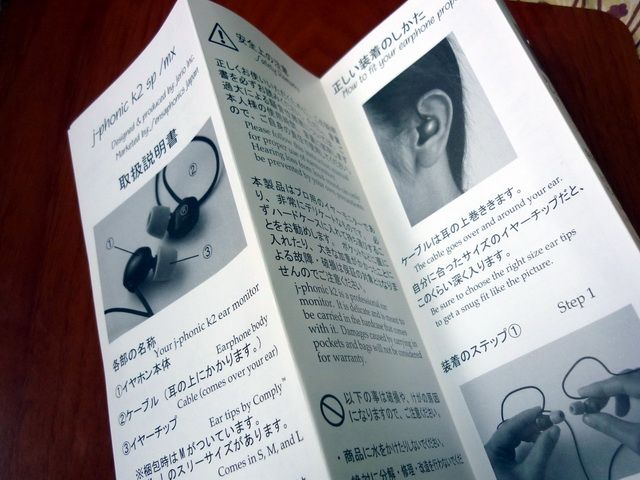

Comply T100 in three different size. Shure olive (bottom left) and Sony Hybrid (bottom right) as reference.
Before we go into the discussion on build quality, I’ll like to talk about the unique ordering process which is quite interesting on its own. First of all, K2 needs to be order directly from j-phonic website as it is not really a factory pre-built, pre-packed item. The manufacturing process starts once you placed the order as there are quite a few options for customization. For Japanese order, the whole package (including shipping) is roughly US$480 or so. For oversea order we actually get it cheaper at $400 including EMS shipping. However all the customization options come with one condition - no refund/return once the order is placed (unless you are requesting a color or sound signature change, with additional fee) as each pair is tailor-made to the order.
So what are the customization options? First, there are 2 type of sound signature (SP / MX). Second, 8 different colors shell (including a transparent option). Third, 2 different termination styles (right angle or straight) on the 3.5mm plug. Fourth, a choice of 3 different cable lengths (40cm, 60cm, and 95cm). Fifth, 2 different colors of Comply foam tips (standard grey or black). Last, 2 different size of Pelican case, each with 3 choices of different color rubber inlay. In total, there are 2 x 8 x 2 x 3 x 2 x2 x 3 = 1152 possible combinations (well, maybe not as much since some options have restriction). There are a few things to note: 1) Unless you have any special need, it is best to pick the 95cm cable for general usage. Cable length actually is counted from the Y-splitter down, so the total length is 35cm (from earpiece to Y-splitter) + 95cm = 130cm. The 60cm option (95cm in total) might be a little too short for the DAP in the pocket, but it is just the right length for the waist, like a wireless transmitter (for In Ear Monitoring System on stage) or a DAP in a waist pack. The 40cm option (75cm in total) is probably only good for something the hangs on the neck like a small DAP or cellphone. It is also suitable for those who are planning to use a mic adapter cable for cellphone, much like the Shure Music Phone Adapter, which probably is why it comes only with a straight mini plug. 2) Because of the length of the cable, the 95cm option is a little too large for the small Pelican case. All in all, I will still say it is quite an impressive level of customization you can get from the K2.
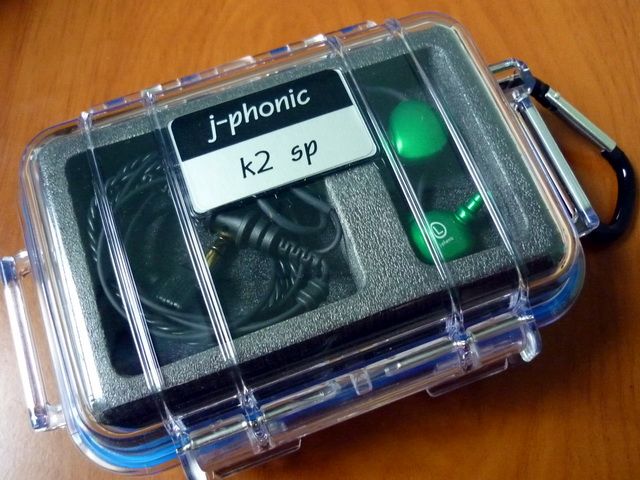
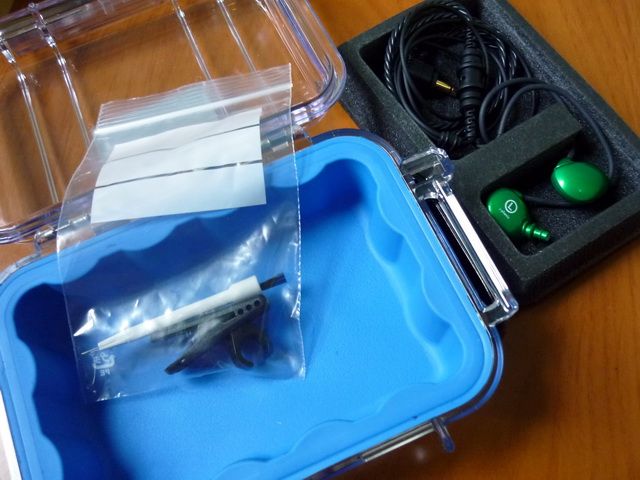
With all these customization, you can imagine the build quality must be pretty good – and indeed it is. First of all, the two balanced armature transducers are actually the same drivers used in some custom. j-phonic simply tuned them to work in the universal shell. the nozzle is filter-less but the foam tip itself should provide enough protection against earwax. You can use Shure black foam (or as we like to call it, the olive) or eartips for narrow nozzle in place of Comply, though they just won’t sound quite as good as Comply since K2 has been specifically tuned for it. For true comfort, Comply is also superior – and I am not talking just typical comfort on typical IEM. The K2 is actually a very comfortable IEM to wear. I once thought Westone UM2 was great on the fit, but K3 beats it by miles. The gorgeous looking, well painted polycarbonate housing is light, slim and almost never touches my outer ear when I am wearing it. Once it is in the ear, it immediately disappears. The cable is pretty good as well. It is the same type of cable uses on custom so it is known to be durable. The cable on the Y-splitter down is twisted, much like a Westone cable, except the cable on K2 is thicker and better twisted. The cable on the Y-splitter up is thinner for better flexibility, but it is by no mean fragile. What I really love about the cable is the heat shrink plastic tube coming out of the ear piece - not only it protects the cable from sweat and acts as a strain relief, but it also holds a curvy sharp and acts like a memory wire (but without any of the associated inconvenience). The Y-splitter is also well built and has a slot for the shirt clip to attach to. Adding to that, the strain reliefs on the cable are also properly made. This is perhaps one of the best, if not the best cable I have even seen on a universal. Microphonic is pretty good and only becomes noticeable when the cable is rubbed by fingers intentionally. Isolation is great, almost as good as Etymotic ER4P, which is one of the most isolated universal.
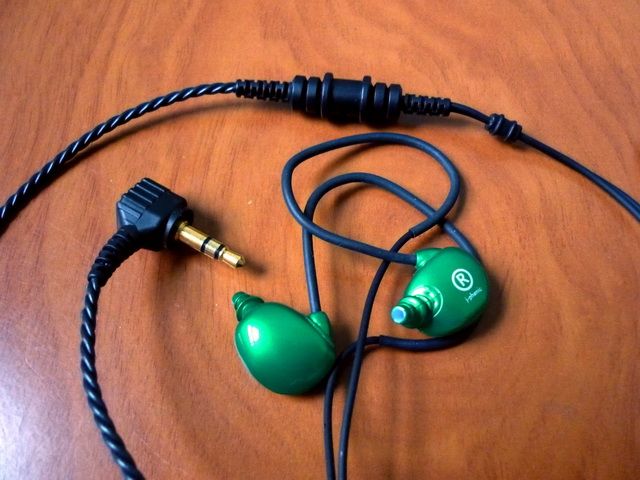
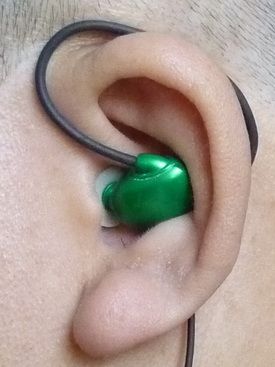
In sum, K2 is very well built and packed. The housing is glued together so there is still a small glue line, but it is much less obvious than UM2 and I don’t really consider it as an issue. The Pelican case looks really pro and great for transport, but it is also a bit bulky for daily usage. I’ll suggest a small hard case for commuting or just easy access and instead use the Pelican case for travel, where protection is most needed. It doesn’t mention in j-phonic website, but K2 comes with a standard 1 year warranty. But since this is such a premier product, I think a 1.5 or 2 years warranty would be an even nicer touch.
Sound Quality
As usual, 50+ hours of burn-in was given before the review though no noticeable change during or after the process. One of the first impressions I have on the K2 SP is the ‘stage monitor’ sound signature that I have been getting quite familiar with in the last few months using the VSONIC GR07. So what exactly is a stage monitor supposed to sound like? There isn’t a real set of perimeters in the pro-audio world that could tell you the answer and almost every companies that sell custom or universal aiming for pro-audio customer will claim that they have the best possible sound for the job among all the competition. But I think there are some common traits we can found on a good pair of stage monitor.
For one, they usually have a neutral but slightly warm’ish sound. Unlike music listening, stage monitor need to be more neutral because the sound often consists of different mix of multiple channels. The singer might want a little more voice and guitar in his/her mix while the drummer probably wants more bass than the guitarist. It is the Front-of-House/ audio engineer job to mix the required amount of different channels for each of the performers on stage. A more neutral sounding IEM simple gives more tweak-able room for the audio guy to work with, as opposes to a colored sound. But why does it have to be slightly warm’ish? My interpretation is, because a slightly warm’ish sound is more relaxing than a cold sound and often carries just a tad more texture. Remember that a stage performer isn’t trying to listen to music critically like an audiophile, but rather listening to sound that is detail and clear on a preferably background-listening volume on an extended period of time without stressing. The last thing a stage performer wants is a sound that either draws too much attention from the listener to the music, or doesn’t give enough detail to the overall sound.
There we come to another trait of a good stage monitor: the lack of major strengths and weakness. A stronger bass response or a brighter treble can be good for different music listening taste, but not so much when you are trying to monitor sound with a fair degree of accuracy. As the job description goes, it also needs to be adaptive to different genre of music, gears and instruments. It is more important to have an even performance to all type sound and music than it is to be particularly good at only a few.
When we look back into these traits that a good stage monitor often share however, it seems like they could serve very well for music listening too. In fact, they often are. The lack of strong personal flavor and their versatility in multi-genre music playback make them a fine choice for those who enjoy good accuracy on low listening volume. This is also where the K2 SP truly excels as both a stage monitor and an audiophile universal.

K2 SP next to another dual driver stage monitor, the Westone UM2. Both with Shure olive.
It is remarkable that two IEM from two different companies, one dynamic while the other is balanced armature based, can each independently reaches the same sound signature where they were both tuned for a reference level monitor sound. While GR07 is an excellent IEM in its own right, the K2 SP just takes the sound quality to the next level. It is neutral to slight warm, with an excellent end-to-end extension and tonal balance. Granted that it does roll off gently at the very low end of the frequency (*sub-bass), bass is still deep, impactful, well bodied, decayed and textured. This is a combination not easily achievable with balanced armature, especially for a dual driver. The quantity is almost matching the dual woofer of a Triple.fi 10 and the quality is only better. While it might still come short compared to some of the best dynamic IEM solely in the bass department, there isn’t that many dynamic that can beat K2 SP’s bass quantity and quality all together. That is quite a feat for what essentially is balance armature’s weakest point.
Mid is also well textured, slightly sweet and upfront, keeping in pace with the bass while not overly done. Vocal shows just a fainted sense of intimacy but in just the right distance not to be in-the-face / too close. Treble is also in line with the rest of the frequency with an almost impeccable quantity and quality. Detail and sparkle is in the right amount not to make the IEM sounding bright or dark, overly analytical or feel the lack there of. Soundstage is above average, but not extremely wide. If there is a weakness that I was forced to accuse K2 SP for, it will be that it doesn’t render soundstage as great as the rest of its sound. It is still quite good, but it is in a small venue instead of a large theater.
From Sara Evans to Diana Krall, Vanessa-Mae to Andre Rieu, Lady Gaga to Fergie, Sara Bareilles to Lenka, James Blunt to Robbie Williams and much more – no matter what genre of music I choose, the K2 SP can render it beautifully. But it is still not what I consider a ‘wow’ type of IEM that will impress people in the first listen. Instead, it is an enduring sound that will draw the listener in with its strong technical ability and effort-less presentation. This is the strength of a stage monitor- allowing the listener to be fatigue free in a long listening session while not losing any focus on the music. What works on the stage can be equally good for the music listener as well.

Verdict
For the price tag of $400, K2 SP isn’t particularly cheap for a universal, and certainly not for a dual balanced armature. But then again K2 itself isn’t really your average mass produced factory item. It is individually hand made in Japan with some of the best parts there are, and with some of the best performance around. Whether you are using it as a stage monitor or simply for music, I believe it is $400 well invested.
In recent year the IEM market seems to get caught with the number game. Almost every other IEM companies are trying to put more transducer in the earpiece. While I don’t personally against the attempts on trying to improve sound quality, I fear that this might encourage an easy way out for some companies to follow the trend with the piling up of transducer number instead of trying to find new and innovative solution. The K2 SP is yet another example to show that with effort in R&D and fine tuning, you don’t necessary have to shove 5 or 6 transducers into each ear piece just to get a good sound. For those who are looking for a top-of-the-line universal, perhaps it will be wiser to look beyond the number as well.
Check out The List for a numeric rating.





